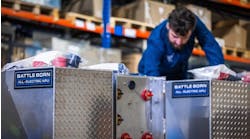Long Beach, CA. Three key themes are developing at the Alternative Clean Transportation Expo, this week: 1) there are a variety of alternative power solutions today from which to chose; 2) many options require strategic and targeted deployment for optimal results; and 3) they are most likely to be successful with the support of good partnerships, solid technologies and some funding.
At the session on vocational applications and pick-up and delivery, Tony Orta--asset manager, fleet services, Southern California Gas Company—noted: “One of the key elements for success in alternative fuel vehicles is partnerships. You won’t be successful if you try to go it alone.”
Scott Perry, group director—vehicle supply management for Ryder, shared some of his company’s experiences with natural gas-fueled vehicles. Ryder is currently deploying 202 natural gas tractors from Freightliner and Peterbilt and he was bullish about the opportunities and realistic about the challenges. “There is not an application that we do not intend to address with these vehicles,” he said, listing grocery, food and beverage distribution, bulk tankers, drayage, utilities and municipal support vehicles among target markets.
When it comes to limitations, Perry’s list was short: “range anxiety” (the fueling infrastructure is limited but growing, he noted), vehicle investment premiums (“incentives are crucial”), and the limited, but growing portfolio of engine options. He also stressed the need to make sure that potential fueling stations can actually handle tractor-trailer combinations. “Many are just for passenger vehicles,” he noted.
Ryder’s interest in natural gas as an alternative fuel was based on four key factors. Perry said the that the company is “well-positioned to support the complexities associated with properly maintaining natural gas vehicles to help guarantee uptime and compliance;” the environmental benefits of natural gas; the relative price stability of natural gas and that the US has an abundant, domestic supply of natural gas to meet its needs now and in the future.
Coca-Cola Refreshments’ North American fleet asset manager, Tony Eiermann, talked about his company’s ongoing investment in diesel-electric hybrid vehicles, which began in 2007. “We began with fifty vehicles in 2007,” Eiermann said. “Last year, we purchased more hybrids than standard diesel trucks. Today, hybrids account for seven to eight percent of our fleet.
“Our trucks are rolling billboards,” he noted. “We have about 650 hybrids deployed now in more than 20 states.”
Eiermann was positive about the fuel-saving contribution that hybrids are making to the bottom line, noting that the company uses 50 million gallons of fuel in a year so that every one-cent rise in the price of diesel adds $500,000 in cost and every penny saved adds up quickly. He also stressed, however, the need to be “very strategic” in deploying hybrids in order to maximize ROI. The sweet spot for hybrids, Eiermann said, was operating in the 20-30 mph range, with minimal miles logged at over 45 mph. A good “stop density” (more than two stops per mile) and positive driver behavior also helped ensure success.
Joe Gold, head of fleet engineering for Frito-Lay, also shared lessons and insights from his company’s use of alternative fuel vehicles, including all-electric vehicles, natural gas and propane conversions, which Frito-Lay has “aggressively pursued.”
“Frito-Lay will have over 300 alternative-fuel vehicles by the end of the year,” he told the audience, and the company is committed to their use to help realize a “leave no trace” company-wide goal, which calls for reducing greenhouse gas emissions by 50% by 2020.
When it comes to obstacles, Gold echoed some of the issues raised by other presenters, including the need for building out the fueling and support infrastructure and that funding is tied to the often-burdensome grant process. However, these did not appear to dampen his enthusiasm or resolve. To increase the likelihood of success, Gold stressed the importance of forming OEM and supplier partnerships with companies who understand the realities of maintenance, sourcing spare parts and other operational realities. “You have to build a team with the right competencies,” he said. “Then you have to let others help lead and be a part of it.
“Each technology has a place in our fleet,” he added. “Nothing will work everywhere, but everything will work somewhere.”
Chris Rice, Clean Energy program manager for the State of Maryland and Clean Cities coordinator for the Maryland Energy Administration, spoke about his state’s hybrid truck initiative. From Rice’s point of view, success was also based in attending to details. “From the government perspective, projects must be technologically, economically and administratively feasible for all partners,” he noted, adding that it is important to “respect and utilize the expertise of all partners in a project.”
Wright & Filippis, Tom Hopkins, department head—central warehouse and distribution, noted: “Partnerships made it easy to move our projects forward.” The company successfully managed to fund 100% of its investments in alternative fuels with grants, realizing a payback in about 2.5 years. By 2009, they had reduced fuel consumption by 27%, working with Roush CleanTech and Ferrellgas as partners.



